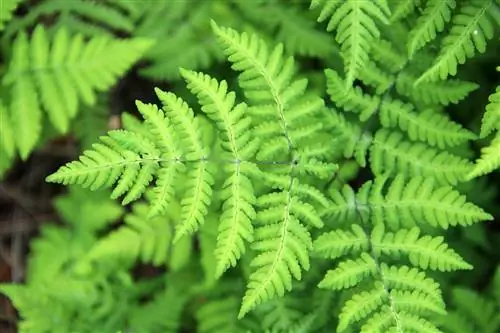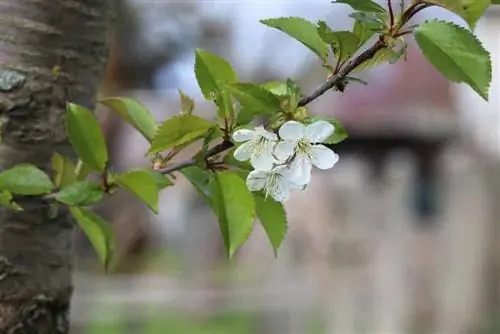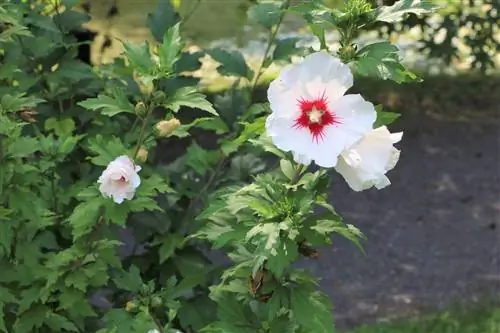- Author admin [email protected].
- Public 2023-12-17 03:39.
- Last modified 2025-06-01 06:48.
The garden marshmallow is a special winter-hardy specimen with different varieties totaling over 200 species of hibiscus, only some of which can be found in Central European gardens. The garden marshmallows are quite uncomplicated to care for. However, they react just as sensitively to care errors as other plants and are not fundamentally resistant to diseases or pests. You can read everything you need to know and what you should know about planting, propagating, caring for and overwintering in the professional care instructions below.
Profile
- Name: Garden Marshmallow (Hibiscus)
- Plant family: Mallow family (Malvaceae)
- Genus: Hibiscus
- Origin: originally Asia
- Perennial evergreen plant
- Growth height: up to three meters depending on the variety
- Growth width: depending on the variety up to 1.5 meters
- Flowering time: between July and September
- Flower color: white, purple, red, yellow, orange or two-tone
- Hardy down to minus 20 degrees Celsius
Location
The garden hibiscus likes a sunny location where it can still be protected from the blazing midday sun. It does just as well in partial shade. A location where it receives sun in the morning and evening is ideal, which promotes its growth and, above all, the formation of flowers. It is important for the period between autumn and spring that it is placed sheltered from the wind so as not to be hit by icy winds.
In addition, it should not be planted too close to water or plants with very high water requirements. This would pose the risk of overwatering and possibly cause root rot. Planted as a shrub or hedge, the marshmallow is suitable for a location where it is intended to provide privacy due to its dense branching or to freshen up boring garden areas with its flower color.
Soil texture
The hibiscus derives a large part of its viability from the soil in which it is planted. Accordingly, it should meet his requirements in order to achieve he althy growth and a long lifespan.
- Nutritious soil
- Water permeable
- If necessary, loosen the soil with sand or perlite
- ph value: acidic below 6.5
Planting time

The best planting time is early spring, provided it is a hardy hibiscus specimen. If frost occurs again on the ground, it won't bother him as long as it only occurs for a short time. If this is not foreseeable, planting should be postponed until the weather conditions have stabilized and prolonged frost is no longer expected.
The marshmallow needs a little longer than other types of hibiscus to get used to the soil conditions. Therefore, planting relatively early is recommended if you want the garden hibiscus to thrive in the first summer season.
Plants in the garden
Although garden marshmallows are quite undemanding, professional planting is necessary so that they can live a long, he althy life. The following details should therefore be taken into account when planting in the garden soil:
- Wide-growing hibiscuses require at least two meters of distance from their plant neighbors
- Before planting, place the plant ball in a water-filled bucket for 24 hours
- Dig the planting hole
- The planting hole must be twice as deep and three times wider than the root ball
- Minimize the risk of waterlogging by spreading perlite, quartz sand or gravel on the planting soil
- Work compost into the soil
- Insert the root ball into the planting hole
- Pour the excavated soil into the planting hole and tamp it down
- Pour generously
- Keep the soil well moist in the first few weeks, but do not overwater it
Plants in pots
As a container plant, the garden marshmallow is planted in a similar way to the garden bed. Since the risk of drying out is higher here, it is advisable to choose an appropriately large bucket that has a soil volume that is at least twice as large as the size of the root ball. It is recommended to use a high-quality substrate instead of soil.
This should be rich in nutrients and potassium and may contain small amounts of sand in order to achieve loosening and thus improved water permeability.
To avoid waterlogging after heavy rain or excessive watering, the plant pot should have a drainage hole and be placed on a saucer. If water collects here, it should be removed from the saucer.
Pouring
As a rule, it rains sufficiently often in Central Europe, even during the summer months, so that the hibiscus in the garden gets along well with the natural amount of rain. If a long dry period meets hot temperatures, watering is necessary. Watering may be generous here, but waterlogging should still be avoided.
You can optimally reduce the need for watering by spreading a thick layer of bark mulch or, even better, gravel on the surface of the soil in the area of the roots. This keeps the soil moist longer because the heat cannot reach the soil directly. With the layers you also benefit from fewer weeds, which have a harder time developing in the soil due to the lack of light.
Fertilize
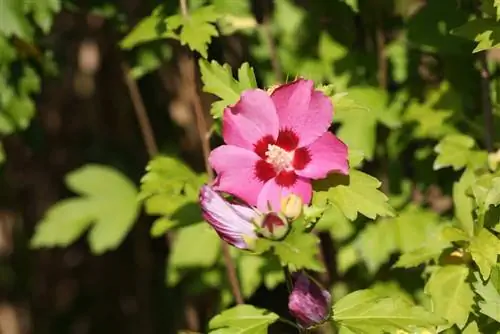
The frost-resistant garden marshmallows are also undemanding when it comes to fertilizer requirements. Occasional fertilizing with compost is sufficient as standard fertilization. Only for magnificent flower growth and a long-lasting flowering period, it is recommended to use a liquid fertilizer shortly before the flowering period begins in June. There are special hibiscus fertilizers available from garden retailers that contain everything the plant needs during the energy-sapping flowering season and for strong flower growth. Fertilizing can be stopped again from the beginning of September.
Cutting
The most important feature that makes the garden hibiscus so popular are the numerous, strong flowers. These generally only form on annual shoots, which is why the marshmallow must be cut once a year. Cutting is done at the beginning of May at the earliest, as this type of plant sprouts late. However, it is optimal if you wait until after the Ice Saints, because the fresh cuts are at risk of frostbite.
Generally, the interfaces should be coated with resin or carbon powder to seal them. In addition to protecting against frostbite, this also helps minimize the risk of illness due to infections. Cut the young plants back down to the main stem, especially in the first two years, to promote branching. When cutting older plants, you should follow the following instructions:
- If branches cross, cut one off at the base
- Cut inward branches completely
- Short outer branches by a third
- Trim branches that protrude above the crown
- Inner, straight-growing branches starting from the main trunk, remove at the base
- Separate withered and dry branches close to the ground
- Best time to prune: on a dry day out of direct sunlight
Tip:
If you discover sick and weak branches or shoots during the summer season, you should cut them off quickly. They unnecessarily remove a lot of nutrients from the plant, which it then lacks for growth and flower formation.
Wintering
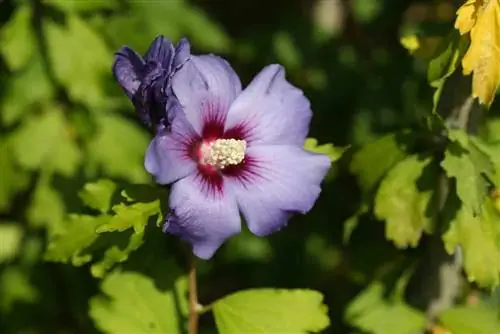
The winter-hardy specimen of a hibiscus defies icy outside temperatures of up to minus 20 degrees Celsius. Basically, the older the plant, the more resistant it is to cold. This means that young garden marshmallows can still react somewhat sensitively to icy temperatures. This affects hibisks in their first and second year of life when temperatures are constantly below 0 degrees Celsius. You should then protect these with special measures and note the following:
- Cover the earth's surface in autumn with leaves, brushwood, bark mulch or pine needles
- In extreme sub-zero temperatures, wrap a jute sack or something similar around the young plant
- Provide protection from the wind
- From 0 degrees Celsius, pull protective layers on the earth outward to prevent mold formation
- Place all marshmallows in a bucket on a cold-insulating plate, such as Styrofoam or wood
- Alternatively place potted young plants in a bright garden house
- Wate dry hibiscuses lightly occasionally
- The darker the hibiscus is in winter, the higher the chance that it will lose its leaves
- Do not fertilize old or young marshmallows during the winter season
Propagate
In order to provide your own garden with an immense display of flowers, it is worth propagating the garden marshmallow free of charge. This can be easily carried out by anyone without having any special expertise or a special “green touch”.
Sowing
You can buy hibiscus seeds from specialist retailers or get them from one of your plants. As soon as the first flowers are fully ripe, which is usually the case in mid/late August, the seeds are perfect for sowing. Once you have collected these, proceed as follows:
- Spread the seeds on newspaper or kitchen paper and let them dry
- After about 2 days, store seeds airtight and dark until spring
- Sowing outside possible from mid/end of May
- Slightly score the seeds with a knife
- As a light germinator, the seeds are only scattered on the ground
- Mix soil with special growing substrate
- Put transparent plastic film over the seed
- Spray seeds lightly with water regularly
- Germination time: approximately seven days
- Remove foil from a height of around five centimeters
- If necessary, transplant from a height of around 15 centimeters to create more space
If you sow the seeds in a seed box instead of outdoors, the chance of multiple specimens increases. In the open field, the light germinators are often stolen by birds, especially in spring, and you can wait in vain for germination. Sowing in a pot or a seed box is the same as in garden soil.
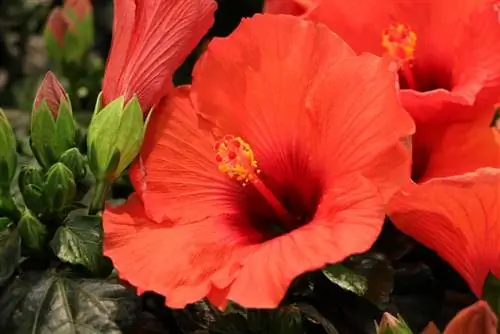
Here, however, you should limit yourself to growing soil and prick out the young plants when they are five centimeters high. From 15 centimeters onwards, you can bring them outside in a pot and put them in a frost-free place to overwinter in autumn. From next spring, the young plants will be strong enough to be planted in the garden soil.
Cuttings
Propagation from cuttings works best if you do it during the summer months. Here you proceed as follows:
- Select a shoot that is approximately 15 centimeters long with at least three eyes
- Remove lower leaves
- Dip the interface into rooting powder
- Put into a pot with potting soil about five centimeters deep
- If necessary, stabilize the cutting with a wooden stick
- Keep soil evenly moist
- Location: bright without direct sunlight
- Optimal ambient temperature: 20 degrees Celsius
- Root formation: approximately after fourteen days
- Repot when new leaves appear
Alternatively, you can also place the cutting in a glass of water. Here you can see better when the roots are forming. It is important that you change the water every two days and only use lime-free water.
Diseases
Garden marshmallows are generally considered to be robust plants. Nevertheless, it is not uncommon for them to be victims of various illnesses, which are mainly caused by care errors. Quickly identifying what the plant is missing and a professional response usually allow successful treatment.
Root rot
Root rot is usually a result of too much watering. You can recognize this by the drooping branches that bend easily and by the increasingly yellowing leaves. Flowers often fade shortly after the buds open, if they open at all. In addition, a musty smell can be noticed above the soil layer.
If the plant is still relatively manageable, you can combat root rot as follows:
- Dig up roots
- Short all root strands by at least a third
- Cut roots affected by mold at least by half
- Place the root on an absorbent material, such as newspaper
- Let dry for at least three days
- Enlarge planting hole by a third
- Mix dry soil with nutrient-rich substrate or compost
- Line the planting hole with soil all around
- Reinsert Hibiscus
- Close the hole again with the remaining soil
- Just pour lightly
- In the next few weeks, allow the soil to dry slightly before watering
Marshmallows that cannot be planted out should be exposed to the roots and allowed to dry out in place for a few days. Then replace the old soil with fresh, dry soil and fill the hole again. Unfortunately, this method is usually only successful in very dry and warm weather conditions.
Chlorosis

This disease results in yellowish leaves, which are caused by a lack of nutrients. This is usually due to a poorly chosen location with too little light or the plant being exposed to cold winds. Moving to a more suitable location and fertilizing with lots of nutrients will help here. The yellow leaves fall off on their own and the plant recovers quickly.
Pests
Pests such as aphids and spider mites like to attack garden marshmallows. Quick action is required here, if only to ensure that neighboring plants are not attacked and the pests spread throughout the garden.
Aphids
Typical signs of an aphid infestation are:
- crippled or curled leaves
- Buds fall off
- A sticky coating, honeydew, which is mainly found on the stems, but also on the undersides of the leaves
Aphids also sit on the leaf stems and branches. Their color is usually light and they are easy to see with the naked eye. As a first step, if possible, isolate the plant from others. Once planted, this just becomes less feasible. So act quickly, give the plant a good shower and remove the aphids in large numbers.
To do this, place your thumb and index finger on the branch or stem, press them together slightly and then pull your fingers upwards. This is how they collect aphids. To reach everyone, further treatment is necessary. Nettle broth is environmentally friendly and very effective:
- Collect two handfuls of fresh nettles
- Dip into a bucket of two liters of cold water
- Let it steep for about twelve hours
- Sifting out nettles
- Pour the broth into a squeeze bottle
- Spray the marshmallow from top to bottom with it every day
- After a week there should be no more aphids
Spider mites
Spider mites love dryness and leave cobweb-like webs on their hosts and light spots on the leaves. Depending on the type and temperature, the color of spider mites can vary between pale green, reddish brown, yellow-green and orange. They are difficult to see with the naked eye. A little trick quickly helps you get spider mites under control easily:
- Shower Hibiscus vigorously
- Wrap translucent plastic film as airtight as possible
- Remove the foil after four days
- Shower the plant again thoroughly
- If necessary, the foil coating can be repeated one more time
Varieties/species
The best-known hibiscus varieties that can also overwinter outside include
- Hibiscus syriacus - Syrian yew
- Hibiscus trionum - hour flower
- Hibiscus arnottianus - garden shrub marshmallow (frost hardy)
Conclusion
The marshmallow is a wonderful specimen that brings color to any garden. With little care required and a robust constitution, illnesses can hardly harm him, which are usually due to care errors anyway. It can be propagated without any problems and has no above-average demands in any other area. So a perfect garden plant for every hobby gardener and everyone who avoids a lot of gardening but doesn't want to miss out on pretty seas of flowers.


